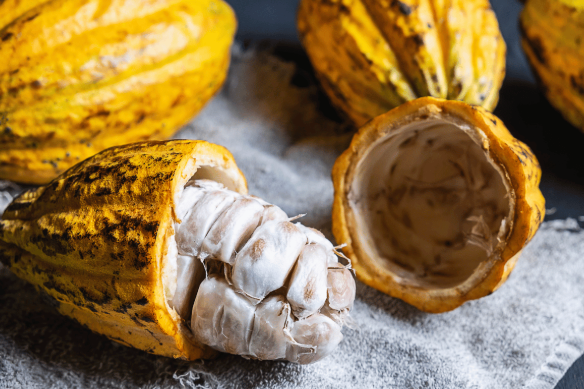
What Cacao Varieties Are There in Costa Rica?
Compartir
Costa Rica is one of the few countries that produces exclusively fine-flavor cacao, a superior category of beans representing only about 12% of the world cocoa market. That means that our chocolate has a rich and balanced base of chocolate flavor along with hints of more complex flavor notes, such as fruit, caramel, roasted coffee and nuts.
While there are about 11 different types of cacao, grouped by the physical shape and texture of cacao pods, there are three historical classifications of cacao.
⸻
➤ Criollo
Among the rarest and most sensitive cacao types in global cultivation stands Criollo. Criollo beans are prized for their delicate flavors that include floral and fruity undertones with low bitterness. Artisanal chocolate makers and premium chocolate producers are always looking for cacao that shows criollo genetics, usually identified by white or creamy internal color of the fresh beans. However, Criollo cacao yields much lower production levels and are more susceptible to disease.
Sibö has found some criollo genetics present at one of our partner farms. But most farmers worldwide will replant using heartier types of cacao to guarantee productivity and resistance to diseases.
⸻
➤ Trinitario
The Trinitario cacao resulted from crossing Criollo with Forastero genetics to unite the flavor qualities of Criollo with Forastero's disease-resistant characteristics. Trinitario stands as the leading variety in Costa Rica when it comes to fine flavor cacao production. The flavor profile of Trinitario cacao changes according to its cultivation area since it produces notes that range from nutty to spicy and from fruity to floral. Sustainable cacao farms choose Trinitario because it offers both disease resistance and flavor quality.
⸻
➤ Forastero (Amazónico)
Forastero stands out for its disease resistance and high productivity which makes it suitable for industrial chocolate manufacturing. Forastero produces a strong and bitter flavor profile with minimal aromatic characteristics when compared to Criollo and Trinitario cacao beans.
⸻
➤ CATIE Clones
The Center for Tropical Agricultural Research and Higher Education (CATIE) has established genetic cacao clones that offer disease resistance together with high yields and refined flavors. The sustainable cacao farming sector relies on these varieties to protect both flavor quality and economic stability for farmers.
Sibö partner farms have greatly benefitted from using some genetics from CATIE’s research.
What are the effects of cacao development programs in Costa Rica?
The efforts of institutions such as CATIE have resulted in disease-resistant cacao clones that preserve favorable flavor characteristics in Costa Rica. The development of resistant cacao clones by institutions like CATIE led to cacao farming renewal which established sustainable operations capable of competing in the international fine chocolate market.
CATIE houses over a thousand cacao species in a living genetic cacao bank in Tuirrialba, Costa Rica.
⸻
How does terroir impact cacao flavor in Costa Rica?
For thousands of years, ancient lava flows and volcanic ash have fed these lands with nutrients and minerals to form a rare type of soil called Andisol. This rich earth and year-round warm, tropical weather contribute to our cacao’s unique terroir. From region to region, and even from farm to farm, you’ll find surprising flavor notes that distinguish our Costa Rican chocolates from other cacao producing countries around the world.
Costa Rica's various microclimates which span from humid lowlands to mountainous regions determine how cacao flavors develop
⸻
What methods do farmers use to produce cacao?
The farmers of Costa Rica are now uniting their ancient agroforestry traditions with modern cacao growing techniques. The practice of growing cacao under the partial shade of taller native trees helps maintain biodiversity and protects the soil from erosion. Farmers combine grafting techniques with organic farming methods and post-harvest fermentation controls to enhance their bean quality.
Harvesting, Fermentation & Drying
Cacao pods, which mature at different rates, have to be harvested by hand at just the right time. Each pod is cracked open by hand and the fresh beans have to be scooped out and placed in fermentation boxes with care. For the fermentation process to yield the best results, the right temperatures and time for aerobic and anaerobic phases are required. Drying the beans is also an essential step—too slow could lead to moldy beans, too fast could seal in some moisture.
⸻
Sibö Chocolate sources only the best cacao varieties of the country
Sibö Chocolate works together with farmers across the country to source only the best cacao beans. The dark single-origin chocolate bars at Sibö contain distinct flavor notes that bring forth hints of fruity, nutty and floral flavors from the Talamanca, Huetar and Turrialba regions of Costa Rica.
Sibö’s Chocolate Tasting Tour provides guests with a sensorial exploration into fine/flavor cacao. A talk about terroir and fermentation accompany the history of chocolate and a taste of select single-origin chocolates.
Their online chocolate shop presents a diversity of products that showcase the distinct characteristics of Costa Rica's best cacao.